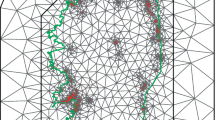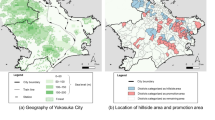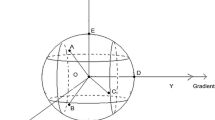Abstract
In the existing housing literature, there has been no academic consensus on how to combine the spatial dependence and the temporal dependence between housing transactions together. The combination is much dependent on the researcher’s priori knowledge of a referent market. This paper attempts to combine them by utilizing an information entropy-based spatiotemporal approach. The validity of the proposed information entropy-based spatiotemporal approach is tested by spatiotemporal regressions in terms of prices estimation accuracy. The methodology is conducted by using data on dwelling transactions from the San Francisco Bay Area. The empirical results suggest that the proposed information entropy-based modeling technique is a reasonable and efficient way to combine the spatial dependence and the temporal dependence.
Similar content being viewed by others
Notes
This problem can be seen in the filtering process in Subsection “The Combination of Building, Regional and Temporal Effects”.
A matrix is row stochastic means the matrix has rows sum up to one.
Since the constant term is a common divisor, when the row is standardized, it can be divided from each element in the row.
The numbers of variables of different factors are identical in this paper.
This paper selects 68 different linear combinations of weight coefficients. The details are explained in the next subsection.
References
Anselin, L. (1988). Spatial econometrics: methods and models. Boston: Kluwer Academic Publishers.
Arnold, S. F. (1993). Gibbs sampling. In C. R. Rao (Ed.), Handbook of statistics. Amsterdam: North Holland.
Balian, R. (2004). Entropy - a protean concept. In Dalibard, Jean. Poincaré seminar 2003: Bose-Einstein condensation – entropy. Basel: Birkhäuser.
Can, A., & Megbolugbe, I. (1997). Spatial dependence and house price index construction. Journal of Real Estate Finance and Economics, 14, 203–222.
Case, A. C., Rosen, H. S., Hines, J. C. (1993). Budget spillover and fiscal policy interdependence:Evidence from the states. Journal of Public Economics, 52, 285-307.
Chan, L. K., Kao, H. P., Ng, A., & Wu, M. L. (1999). Rating the importance of customer needs in quality function deployment by fuzzy and entropy methods. International Journal of Production Research, 37(11), 2499–2518.
Cleveland, W. (1979). Robust locally weighted regression and smoothing scatterplots. Journal of the American Statistical Association, 74, 829–836.
Dyer, J. A., & Sarin, R. K. (1979). Measurable multi-attribute value functions. Operations Research, 27, 810–822.
Fotheringham, A. S., Brunsdon, C., & Charlton, M. (2002). Geographically weighted regression: the analysis of spatially varying relationships. Chichester; Hoboken: Wiley.
French, N. (2007). Valuation uncertainty - common professional standards and methods. Paper presented at the 13th Pacific-Rim Real Estate Society Conference, Fremantle, Australia.
Ge, X. J., Lam, K. Y., & Lam, K. C. (2005). Entropy method in the rank of attributes for property value. Paper presented at the proceedings of the 3rd international structural engineering and construction conference, Shunan, Japan.
Gelfand, A. E., & Smith, F. M. (1990). Sample based approaches to calculating marginal densities. Journal of the American Statistical Association, 85, 398–409.
Geman, S., & Geman, D. (1984). Stochastic relaxations, Gibbs distributions and the Bayesian restoration of images. IEEE Transactions on Pattern Analysis and Machine Intelligence, 6(6), 721–741.
Geweke, J. (1993). Bayesian treatment of the independent student linear model. Journal of Applied Econometrics, 8, 19–40.
Goodman, A., & Thibodeau, T. (1995). Dwelling age heteroscedasticity in hedonic house price equations. Journal of Housing Research, 6, 25–42.
Hall, R. E. (1971). The measurement of quality change from vintage price data, in price indexes and quality change, edited by Zvi Griliches. Cambridge: Harvard University Press.
Hulten, C. R., & Wykoff, F. C. (1981). The estimation of economic depreciation using vintage asset prices: an application of the box-cox power transformation. Journal of Econometrics, 15, 376–396.
Kapur, J. N. (1989). Maximum-entropy models in science and engineering. New York: Wiley.
LeSage, J. (1999). The theory and practice of spatial econometrics. Working Paper. Department of Economics. Toledo: University of Toledo.
Ord, K. (1975). Estimation methods for models of spatial interaction. Journal of the Statistical Association, 70, 120–126.
Pace, R. K., & Gilley, O. W. (1997). Using the spatial configuration of the data to improve estimation. The Journal of Real Estate Finance and Economics, 14(3), 333–340.
Pace, R. K., Barry, R., Clapp, J., & Rodriguez, M. (1998). Spatial–temporal estimation of neighborhood effects. Journal of Real Estate Finance and Economics, 17, 15–33.
Pace, R. K., Barry, R., Gilley, O. W., & Sirmans, C. F. (2000). A method for spatial- temporal forecasting with an application to real estate prices. International Journal of Forecasting, 16, 229–246.
Palmer, J. L., & Pettit, L. I. (1996). Risks of using improper priors with Gibbs sampling and autocorrelated errors. Journal of Computational and Graphical Statistics, 5(3), 245-249.
Pandurangan, G., & Upfal, E. (2007). Entropy. ACM Transactions on Algorithms, 3(1), Article No. 7.
Shannon, C. E., & Weaver, W. (1963). The mathematical theory of communication. Urbana: University of Illinois Press.
Sun, H., Tu, Y., & Yu, S. (2005). Spatio-temporal autoregressive model for multi-unit residential market analysis. The Journal of Real Estate Finance and Economics, 31(2), 155–187.
Tu, Y., Sun, H., & Yu, S. (2004). Transaction-based office price indexes: a Spatialtemporal modeling approach. Real Estate Economics, 32(2), 297–328.
Zanakis, S. H., Solomon, A., Wishart, N., & Dublish, S. (1998). Multi-attribute decision making: a simulation comparison of select methods. European Journal of Operational Research, 107, 507–529.
Zhao, J. (2015). The anisotropic spatiotemporal estimation of housing prices. Journal of Real Estate Finance and Economics, 50(4), 484–516.
Author information
Authors and Affiliations
Corresponding author
Appendix
Appendix
Rights and permissions
About this article
Cite this article
Zhao, J. Information Entropy-Based Housing Spatiotemporal Dependence. J Real Estate Finan Econ 58, 21–50 (2019). https://doi.org/10.1007/s11146-017-9636-x
Published:
Issue Date:
DOI: https://doi.org/10.1007/s11146-017-9636-x




